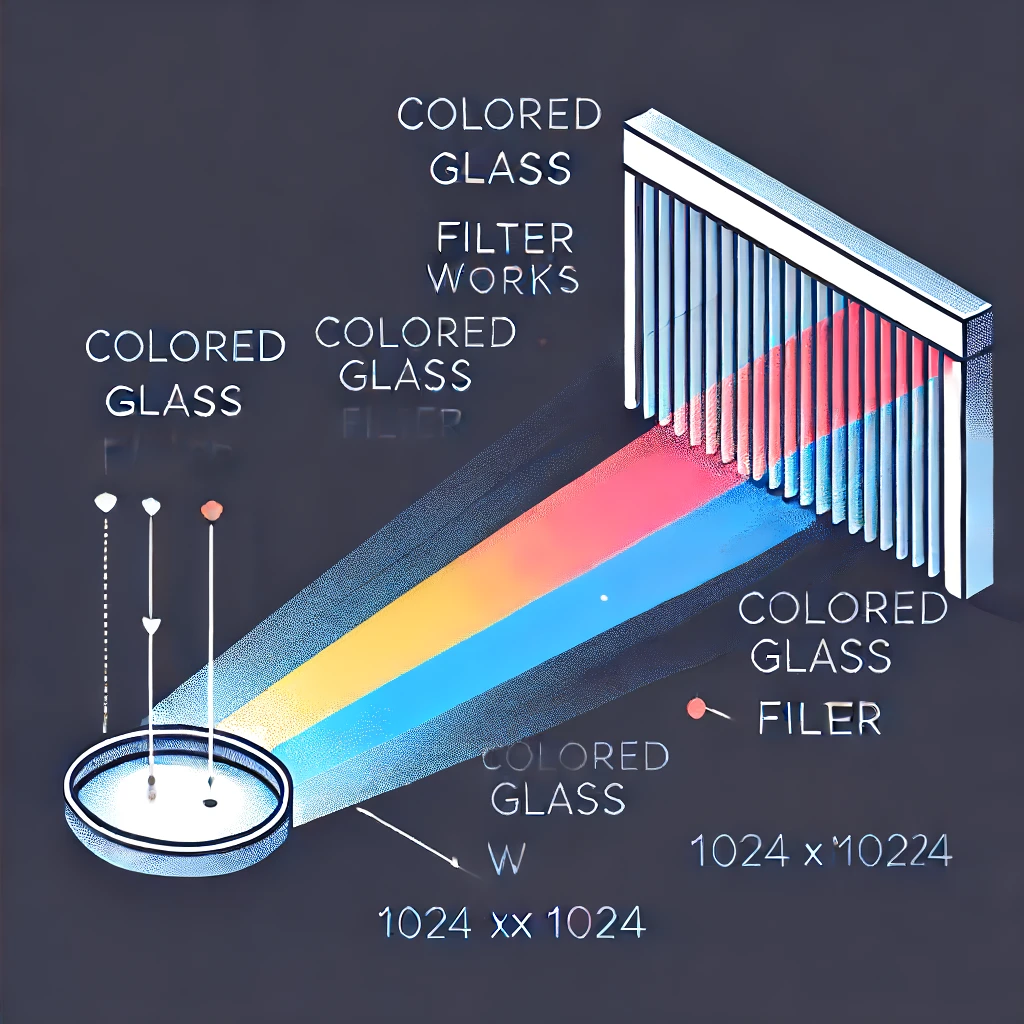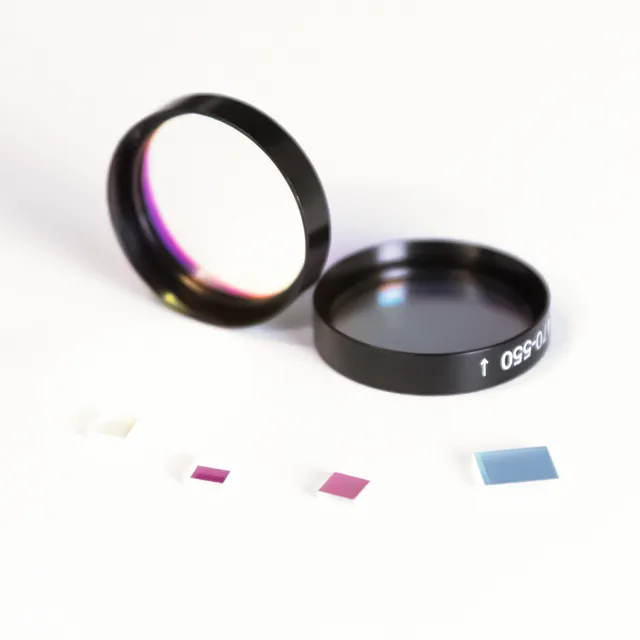Colored glass filters are absorptive optical filters made of high-quality colored glass. They can selectively allow specific wavelengths of light to pass through while blocking other wavelengths.
These filters are widely used in different industries and technologies, contributing to its market growth and considerable revenue forecasts. Let’s explore the definition of colored glass filters and how they work through this article!
What are colored glass filters?
A colored glass filter is a filter used to control the penetration of light at specific wavelengths by using colored glass to absorb certain wavelengths of light and transmit other wavelengths of light.
This filter is often used in fields such as scientific research, photography, optical instruments, and lighting design.
Construction and composition
Colored glass filters are constructed by depositing thin layers of dielectric coatings and metallic coatings onto a single glass substrate. The main components include:
- Glass substrate (A): The base material to which the coatings are applied.
- Dielectric coatings (B): These layers are responsible for the selective wavelength transmission properties of the filter.
- Metallic coatings (C): Enhance the optical performance and durability of the filter.
The hard coating design allows for a rugged monolithic filter that is highly resistant to environmental factors such as humidity and temperature changes. Precise control of the coating thickness and composition allows for fine tuning of the filter’s spectral properties.
How does a colored glass filter work?

The working principle of colored glass filters is based on the fact that colored glass is formed by adding materials of specific colors (such as metal oxides) to glass. The colored glass itself has certain spectral curve characteristics, which can absorb light in a specific spectral range while allowing light from other spectra to pass through.
Through optical coating technology, the light passing through the colored glass can be precisely controlled to have a higher transmittance, a deeper cutoff depth, and a steeper steepness.
Now that you understand the basics of how colored glass filters work, it would be helpful to explore how dichroic mirrors work and what they do to further enhance your understanding of optical technology.
Pros and cons of colored glass filters
Pros
- Enhanced performance. Colored glass filters offer superior performance over coated filters in specific life science applications.
- Optical clarity. These filters have excellent optical clarity, ensuring precise wavelength transmission for accurate analysis.
- Durability. Due to their stable structure, colored glass filters are particularly durable and suitable for a variety of industrial and scientific applications that require long-term use.
- Customization options. Customization services are available, allowing users to tailor the optical properties of the filter, such as wavelength selection and optical density, to specific application needs.
- Cost-effective. Although high-quality, colored glass filters are generally more economical than other high-end filters, providing a viable solution for many projects with limited budgets.
Cons
- Limited range. Colored glass filters can effectively filter a relatively limited range of wavelengths, usually in the visible to near-infrared region, which may not be sufficient to meet the needs of all applications.
- Complex selection process. Selecting the right colored glass filter requires considering multiple factors, including wavelength, optical density, and usage environment, making the selection process complex and prone to errors.
- Potential interference. In some cases, interference issues may occur when using colored glass filters with other optical components.
- Maintenance requirements. When used under a high load or harsh environment, it should be maintained more frequently to ensure the performance and service life of the filter.
What Types of colored glass filters?
Colored glass filters come in a variety of types and can be tailored to specific applications and requirements.
Bandpass filters
These filters allow a specific range of wavelengths to pass while blocking others, making them ideal for applications that require precise wavelength selection.
Shortpass filters
These filters are designed to transmit shorter wavelengths while blocking longer wavelengths and are often used in microscopy and fluorescence imaging.
Longpass filters
These filters transmit longer wavelengths and absorb shorter wavelengths and can be used in astronomy and environmental monitoring.
Neutral density filters
These filters reduce the intensity of light of all wavelengths uniformly without altering color reproduction and are commonly used in photography and spectrophotometry.
Custom Filters
Custom colored glass filters can be tailored to unique specifications and are used in industries such as cameras, physics, chemistry, and medical devices.
By offering a wide range of filter types, colored glass filters meet the needs of a wide range of industries and technologies. Selecting the most appropriate filter type ensures optimal performance and improves the quality of a wide range of optical applications.
How to choose colored glass filters?

To select the right colored glass filters, you need to be aware of the following key factors:
- Consider specific application requirements to determine the ideal filter type.
- Evaluate the wavelength range required for transmission and absorption based on the intended use.
- Evaluate the optical clarity and durability of the colored glass filters for long-term reliability.
- Look for custom filter sites that can customize filter properties to unique specifications.
- Compare cost-effectiveness and ensure high-quality performance in different applications.
- Choose filters that provide enhanced performance, precise wavelength transmission, and versatility across industries.
- Analyze the advantages of colored glass filters over coated filters, especially in life science applications.
- Choose colored glass filters that meet your specific needs to achieve the best results in microscopy, photography, or spectroscopy.
Summary
In this article, we have a detailed understanding of the definition and working principle of colored filters, including their advantages and disadvantages. The ability of colored glass filters to selectively transmit light improves accuracy and efficiency.
As technology advances, the uses of these filters are likely to expand, further highlighting their importance in the evolving field of optical applications. By then, a variety of optical filters will be available on the Optolong website, including some dichroic mirrors, bandpass filters, etc. Come and contact us for a quote!
FAQ
Colored Glass Filters vs Colorless Glass Filters: What’s the Difference?
Colored glass filters contain specific dyes or pigments that selectively absorb and transmit wavelengths of light. They are often used in applications that require precise control of color, such as photography and scientific experiments.
In contrast, colorless glass filters do not alter the spectrum of light; they are primarily used to protect optical components and maintain the integrity of light in systems that require high clarity and transparency.
What is the lifespan of a glass filter?
The lifespan of a glass filter depends largely on its quality, environmental exposure and maintenance, but is typically between 5 and 20 years. Of course, proper handling, regular cleaning and storage in a controlled environment can maximize the lifespan.
